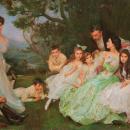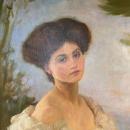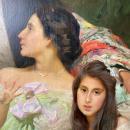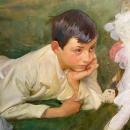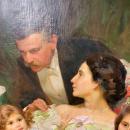John Henry Frederick Bacon (1868-1914) Monumental Family Portrait Oil Painting





$135,000.00
This truly magnificent Art Nouveau period oil on canvas by John Henry Frederick Bacon, A.R.A. (1868-1914), entitled The Golden Butterfly, depicts the family of John and Julietta Boyd-Harvey at Tondu House in South Wales in 1907. 91 by 144 in, 7'1" by 12', 231.4 by 366 cm. It was exhibited at the Royal Academy in London in 1907, no. 572. Provenance: Christie's, London, June 14, 2005, lot 5.
Christie's Lot Essay:
This spectacular portrait depicts the Boyd-Harvey family on the lawn of Tondu House, South Wales, with the mountain and valley of Tondu, near Port Talbot, in the distance. It was painted by the society painter John Bacon, a friend of the family, on the eve of the wedding of Georgiana, the eldest daughter. In the pictorial language of the Edwardians - the Golden Butterfly - the title under which the painting was exhibited at the Royal Academy - was a symbol of marital happiness. A butterfly can be seen above Mr and Mrs Boyd-Harveys' heads.
John and Julietta Boyd-Harvey met under circumstances at once extraordinary, and entirely typical of the age. John Boyd-Harvey was educated in Cornwall, but studied gas production under Thornton Andrews at Swansea gasworks. His brother Robert, elder by thirteen years, had established himself in South America where he had entered partnership with Colonel North, known as 'the Nitrate King' owing to his exploitation of the nitrate deposits of Chile. Aged 21, John journeyed to join him, and there met his wife, Julietta Belvedere Grenadino, on the Chilean-Peruvian borders at the height of the civil war of the 1880s. By 1888 Colonel North had decided to invest in the mines of South Wales, and with a growing family, John Boyd-Harvey was relieved to accept his invitation to manage his interests there: in 1892 he was appointed General Manager and Managing Director of North's Navigation Collieries (1889) Ltd.
The family moved to Tondu House, and Julietta proceeded to bring considerable Spanish flair to the Welsh Valleys. In addition to an indoor staff of seven, three governesses, Miss Mackay, Miss MacLinden, and Miss Dalton, representing Scotland, Ireland and England, were employed to educate the seven children. Three gardeners, two coachmen, and numerous stable hands were also employed, for the family were so numerous that two carriages were required for every journey. The house was altered to accomodate a Catholic chapel, and when the boys were old enough they were educated at Beaumont. Thankfully, Julietta enjoyed a substantial income to supplement her husband's: her uncles were cabinet ministers in the Peruvian government, and she was proud of her descent from Spanish Conquistadors, who were reputed to have married into the Peruvian, Inca 'royal' family.
When her daughter Georgiana married Amaro Duarte y Moreno, of Malaga, Spain, Julietta entertained on a scale previously unseen in her neighbourhood. Effusive descriptions of the wedding appeared in the Lady's Pictorial, with illustrations of the costumes worn and a list of presents given - which included a Daimler limousine. Bacon's portrait, which was on view in the house during the wedding breakfast, encapsulates the family's glamour and prosperity at that time.
Bacon submitted several portraits to the Academy each year, and was skilful in devising interesting compositions from groups containing many figures. His best known pictures are The Coronation of King Edward VII in Westminster Abbey (now in the National Portrait Gallery), and City of London Volunteers return to London from South Africa, 1900 (now in the Guildhall). While pictures by Bacon commemorating civic events have recently appeared at auction, no group portrait painted on such a scale, or executed with such panache, has yet emerged.
